
Photo by Sue Kessler.
By Em Miller
Relatively early in Skidmore Theater’s production of The Hour We Knew Nothing of Each Other, there is a scene in which 14,000 ping-pong balls are dropped simultaneously onto the stage from the fly loft, and then quickly gathered up by the ensemble. The second time I saw the show, shortly after the stage was cleared, Stage Manager Emily Hardy ‘21 unexpectedly called a pause, and then announced into her microphone: “May I have your attention please. A celluloid ping-pong ball, made of a highly combustible material which ignites at a temperature of 248℉, has landed on top of and gotten stuck on the bellcap of an ETC 750-watt Source 4, which has a constant operating temperature of 423℉. The electric is now flying into the deck so that Jared Klein, technical director, can remove it for your safety.” As she spoke, the instrument-laden boom was indeed flown in and Jared Klein stepped out on the stage, to loud cheers from theater students, and walked along the boom until he found the ping-pong ball and plucked it from the lighting instrument. The fire hazard was removed, and the show continued normally, until another ping-pong ball was discovered and the whole operation repeated.
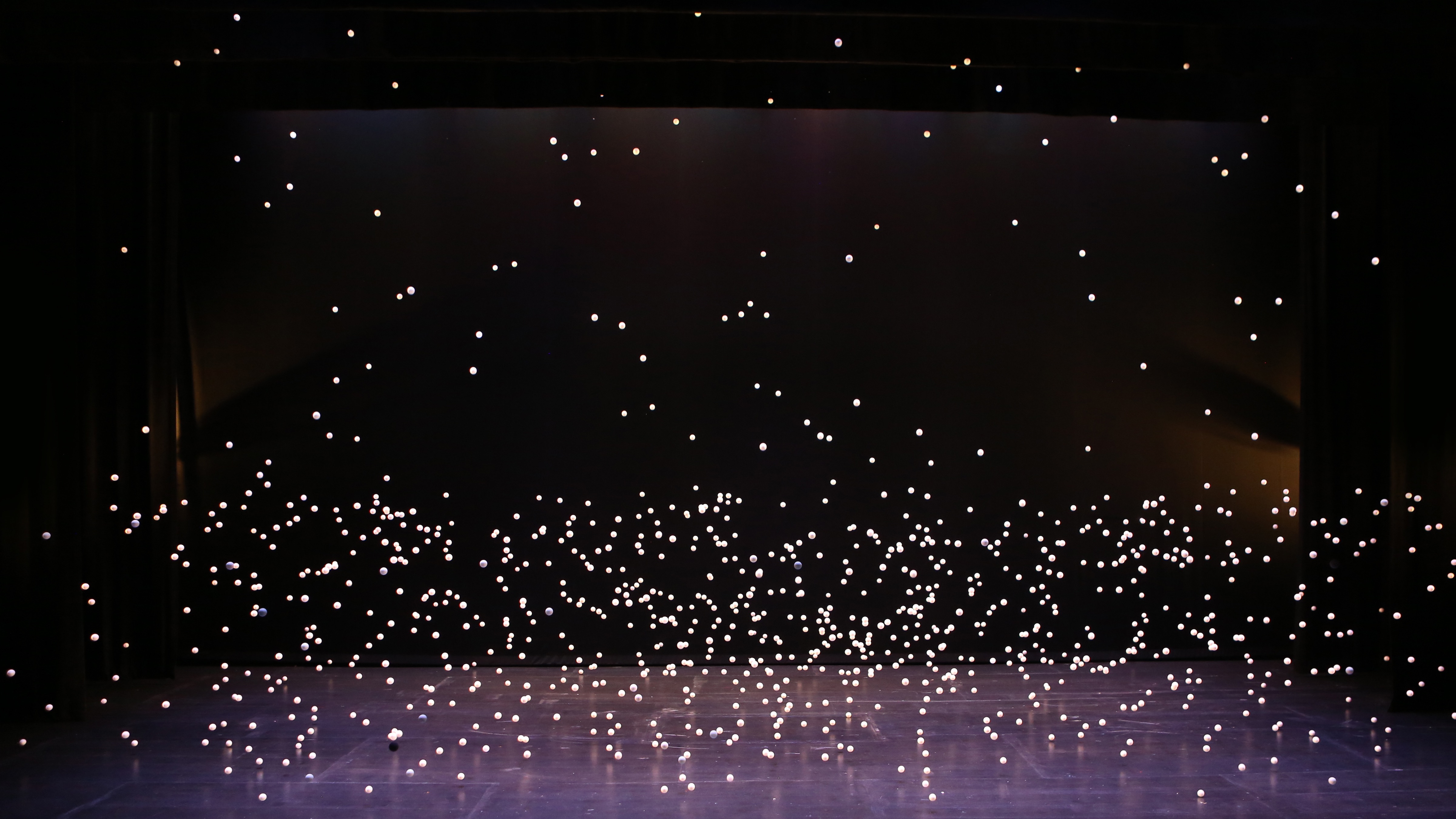
Photo by Sue Kessler.
This solution to a potential problem lends itself perfectly to the improvisational energy and conceptual nature of this production, directed by Phil Soltanoff. The Hour We Knew Nothing of Each Other apocryphally was written after the playwright, Peter Handke, sat in a city square for an hour recording the comings and goings of the populace. This description, however, falls short of the ultimate complexity of the production. Throughout the piece, increasingly surreal, improbable, and arresting moments occurred, from a bride with a veil so long that it took a full minute to drag across the stage, to an overwhelming barrage of sound and video, to the final scene of the play in which all the machinery of the theater was revealed around the actors.
The Hour… presents many challenges for any theater company, such as the fact that the text is entirely stage directions. For this reason, the actors had to approach the piece with an emphasis on gestures and relationality, a technique known as Viewpoints. Sometimes, these directions were read aloud, or projected onto a screen behind the stage, giving the scenes a presentational quality, but mostly the audience only saw how the stage directions were interpreted by the ensemble and director. When asked whether the ensemble would be described as actors, musicians, or dancers–a valid question–Soltanoff explained, “They’re actors, but they’re relating to each other in spatial and musical ways.” The result of this is a play that was extremely physical and sensual in the most literal meaning, both through the performances of the actors and through the many technical elements that the piece used. I left the theater after the first time I saw The Hour… hyperaware of how I walked and moved.
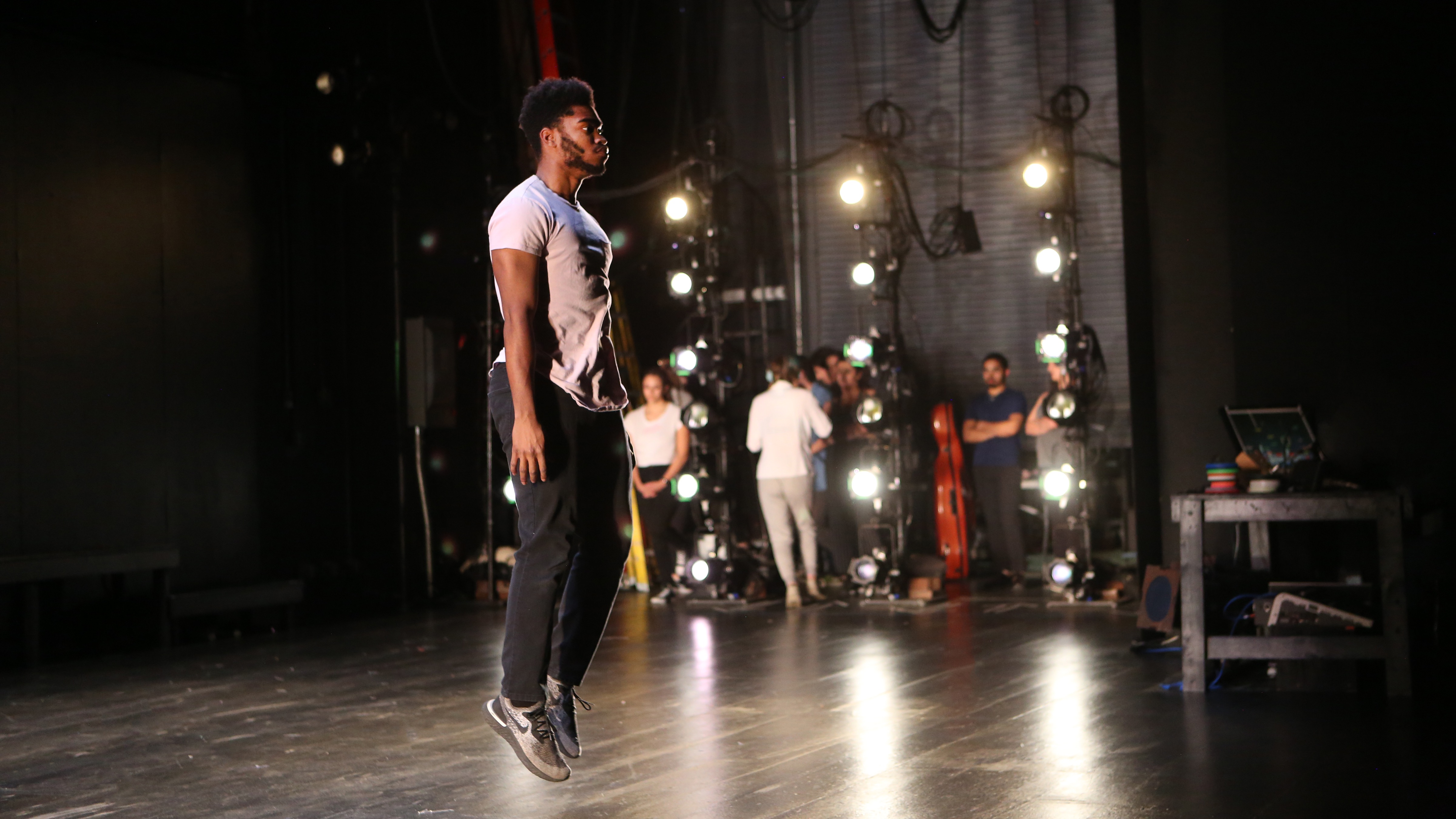
Photo by Sue Kessler.
Much of the play was entirely people walking back and forth across the stage, sometimes narrated, sometimes not. In the beginning, these endless traversals were punctuated by little idiosyncratic character moments: someone asked a stretching jogger for directions, but the directions were inaudible thanks to blasting K-Pop from the jogger’s headphones. A team of chefs rushed through, brandishing cooking utensils. Papageno, from The Magic Flute, crossed the stage in a feathered costume and never returned. As the piece went on, the relative realism of the characters’ actions grew more abstract as their rehearsal clothes were gradually replaced with near-identical business suits.
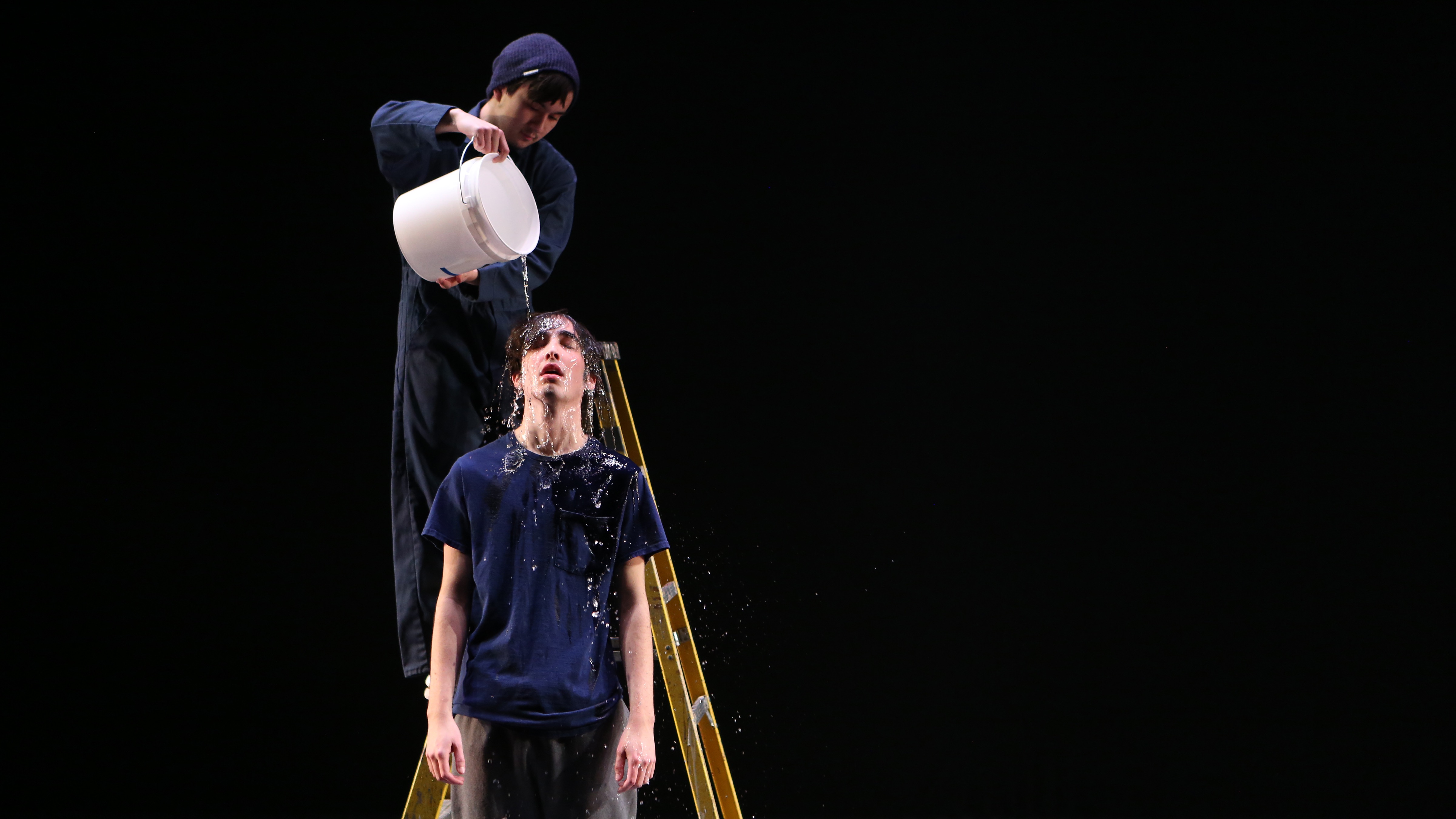
Photo by Sue Kessler.
Once the play reached its technological and conceptual climax, the show had transformed totally from the slice-of-life it seemed to present at first. The video elements overwhelmed the actors, who were now using their bodies to tell a story about conformity and the anxiety and paranoia of not conforming. In one of the most awe-inspiring sequences, any human presence on stage vanished for ten minutes while a set of panels the height of the proscenium were flown in a choreographed dance that interacted with projected minimalist animations of rectangles. For another moment, the ensemble returned to be lit by a fast-paced barrage of esoteric video clips and sound. Actor Jonah Harrison ‘22 described this part as the most powerful for him, thanks to the feeling of “being around other people (on stage and in the audience) and hearing something different and picking up on new things every time since there’s so much going on.” The experience of noticing things differently on repeat viewings was definitely relatable for me, and the show certainly benefited from repeat viewings.
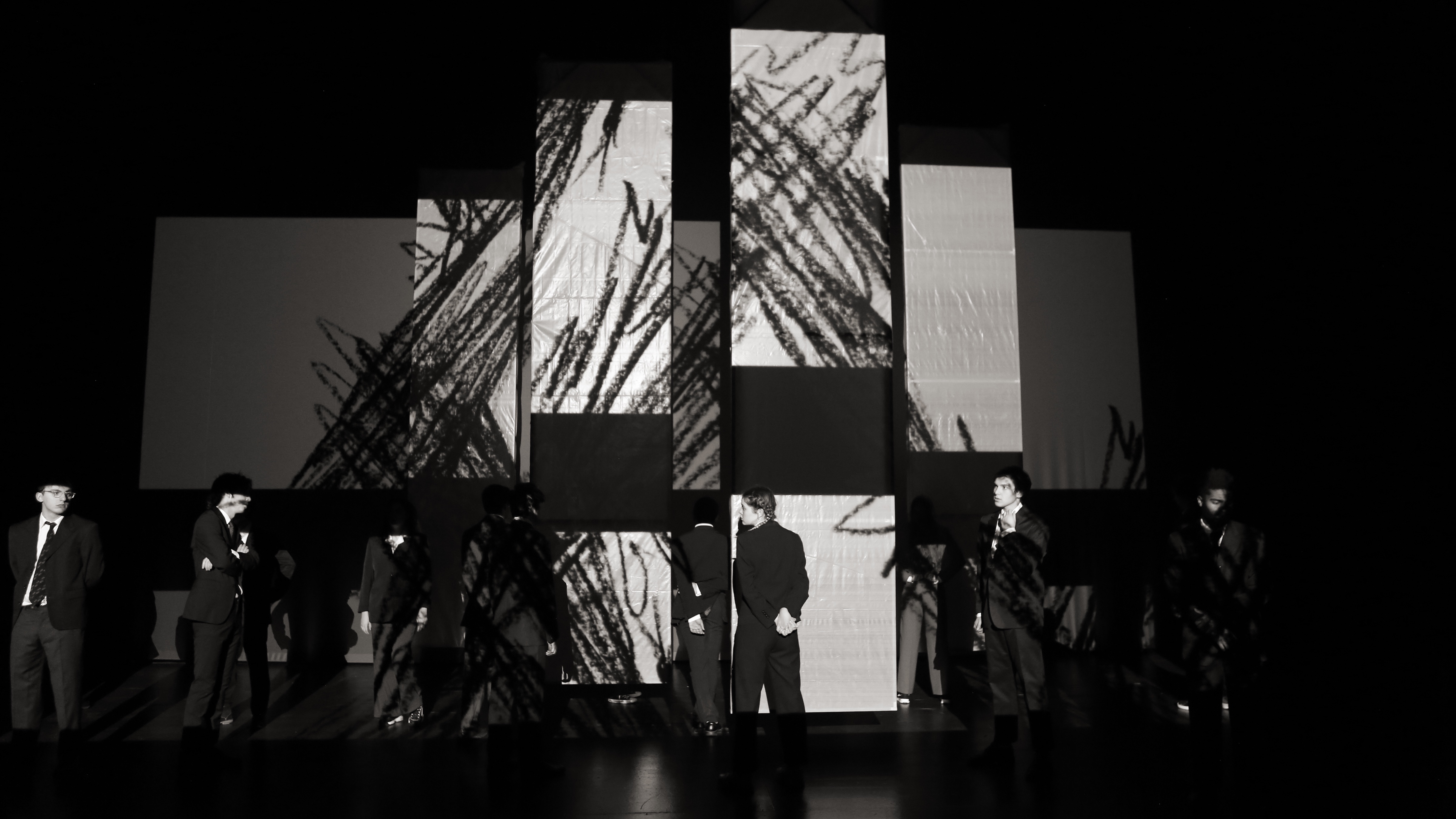
Photo by Sue Kessler.
The central conceit of The Hour… was a repeated contrast between mundanity and spectacle, between small, intimate moments and overwhelming cacophony. What exactly that meant varied from scene to scene, but often it would be the result of the lighting, sound, and video design in conjunction with the bodies of the actors. For instance, the video elements were introduced in a beautiful scene in which a projected bird, made of a delicate tracery of light, was released from an actor’s hands to fly slowly across a series of panels, held by other actors. The projected video stemmed from a collaboration between the Theater Department and the Art Department–the Video Designer (Emily Egan ‘20) and her assistants (Jules Evens ‘20 and FionaMcLaughlin ‘20) are all Studio Art majors. The collaboration was ultimately fruitful, both for the play and for the artists, who have never worked on something of this scale before. Egan stated that working on the piece “changed the way [she] makes work on [her] computer screen,” thanks to the experience of making something that had to be projected onto a screen dozens of feet high, as well as interact with the sound and the actors. Associate Sound Designer August Sylvester ‘20, who worked with the video designers on some technical aspects of the projection, also appreciated the collaboration, because, “It gives people a glimpse into what goes on in the theater, because I think it’s very different from how other art happens.”
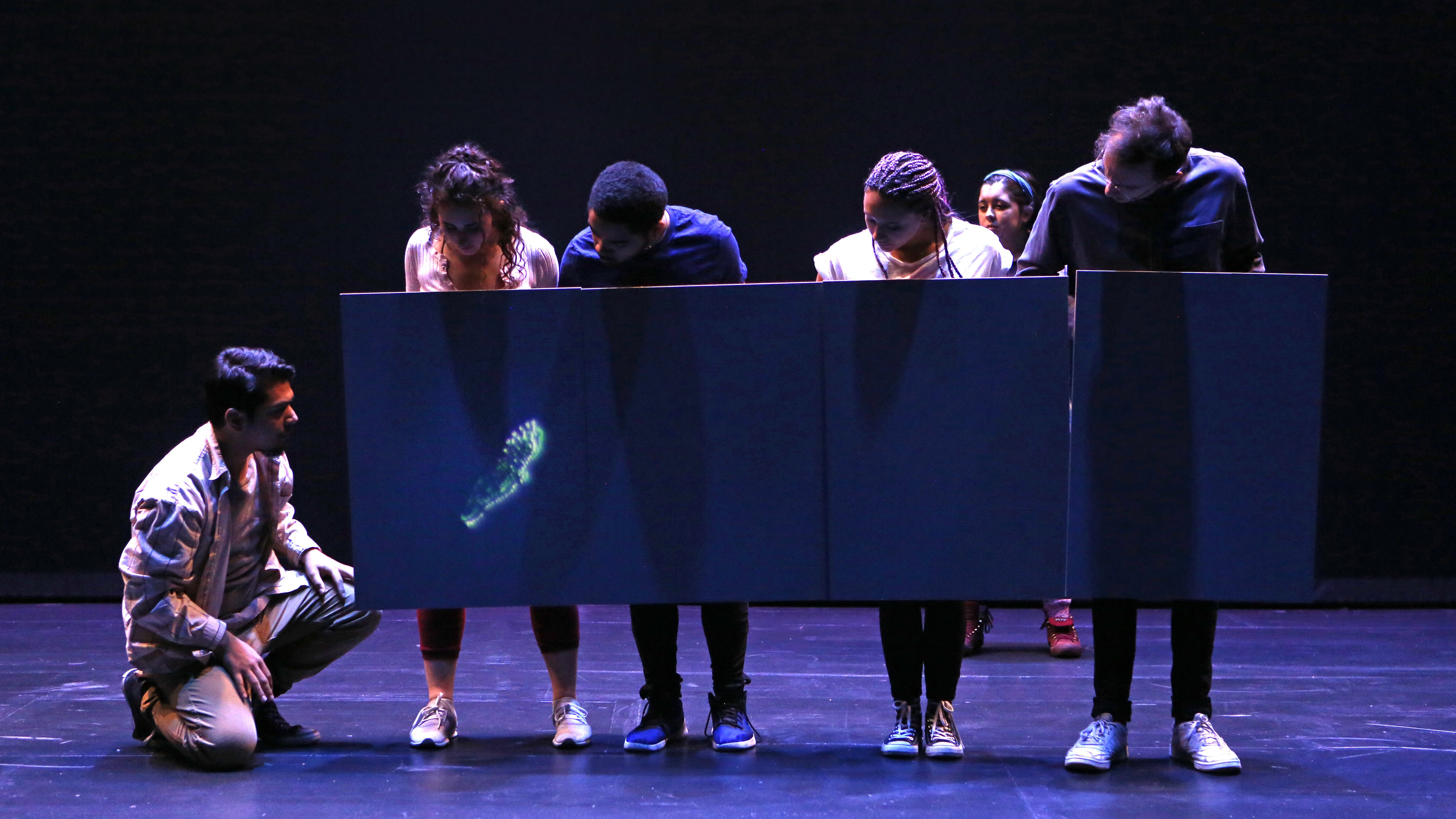
Photo by Sue Kessler.
With respect to his process, Soltanoff stated, “I’m always interested in pushing the capabilities of the space and capabilities of the technology of the theater department.” The Hour… certainly accomplished this, as well as pushing the audience’s and production team’s expectations for theater itself. This sort of pressure is always necessary in any art form in order to discover new things about the medium, and for this play, had incredible results.
Production Credits
Written by: Peter Handke
Directed by: Phil Soltanoff
Scenic Design: Phil Soltanoff
Sound Design: Phil Soltanoff
Associate Sound Design: August Sylvester ’20
Costume Design: Samantha Garwood
Lighting & Associate Scenic Design: Jared Klein
Assistant Directors: Cara Geser ’20 and Sarah Marlin ’20
Props: Jessie Blackman ’20 and Amelia Schuster ’21
Hair Design: L. Esther Hibbs ’19
Video Design: Emily Egan ’20
Stage Management: Emily Hardy ’19
Cast: Ajani Acloque ’22, David Burg ’23, Leandro Bustos ’23, Matt Clyne ’20, Hannah Curtis ’20, Mac Elizalde ’23, Jillienne Leigh Glodowski ’22, Meg Gray ’22, Jonah Harrison ’22, Lily Kops ’22, Max LoSardo ’20, Mary MacKeen ’23, Izzy Maher ’22, Adam Newmark ’20, Tatsu Rivera ’22, Fabian Rodriguez ’22, Julian Schepis ’22, Gemma Siegler ’22, Isabel Sill ’20, Cianna Stovall ’22, Emily Zeller ’22
Photo Gallery
***
Em Miller ’20 is one of the Co-Editors-in-Chief of the Skidmore Theater Living Newsletter





























